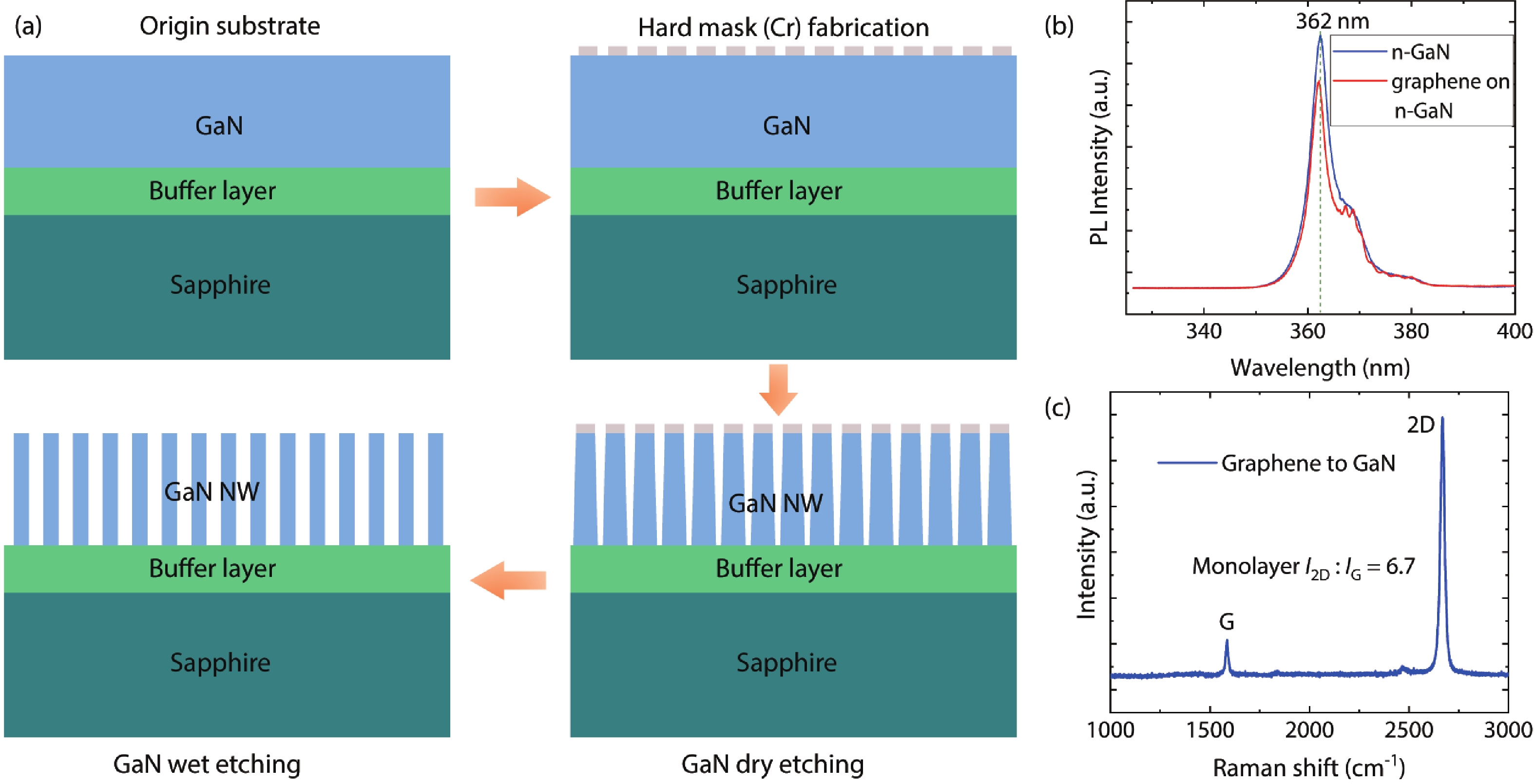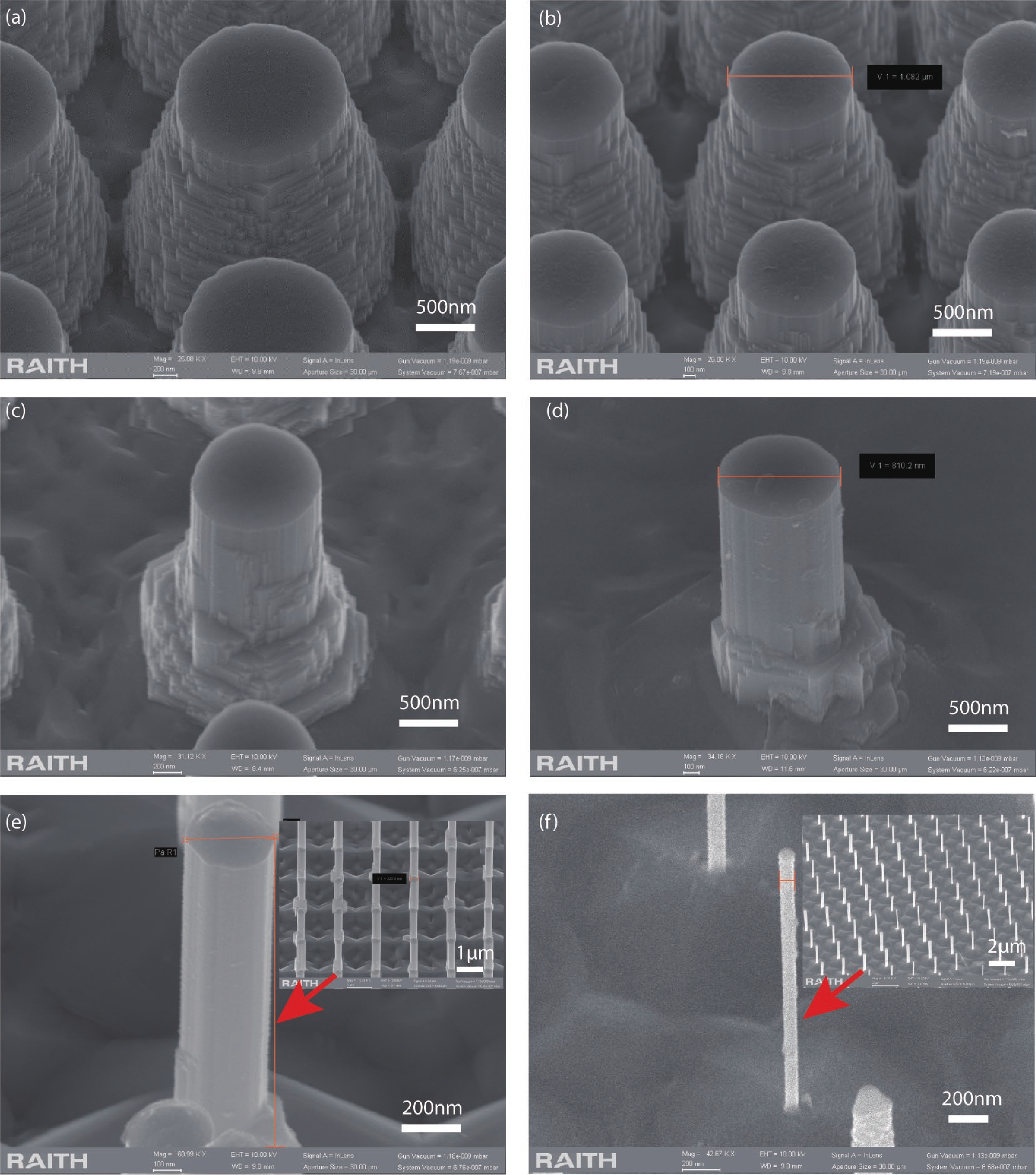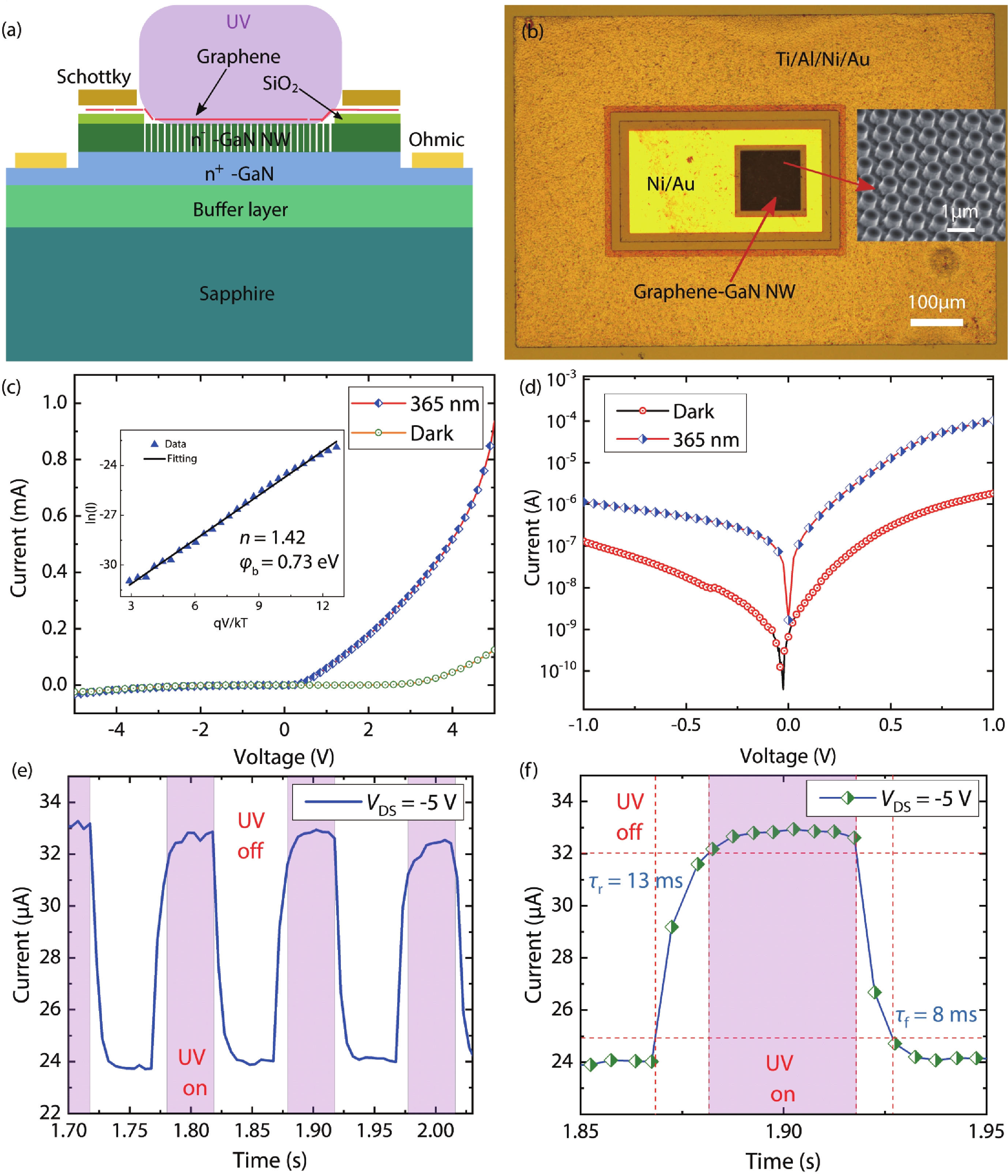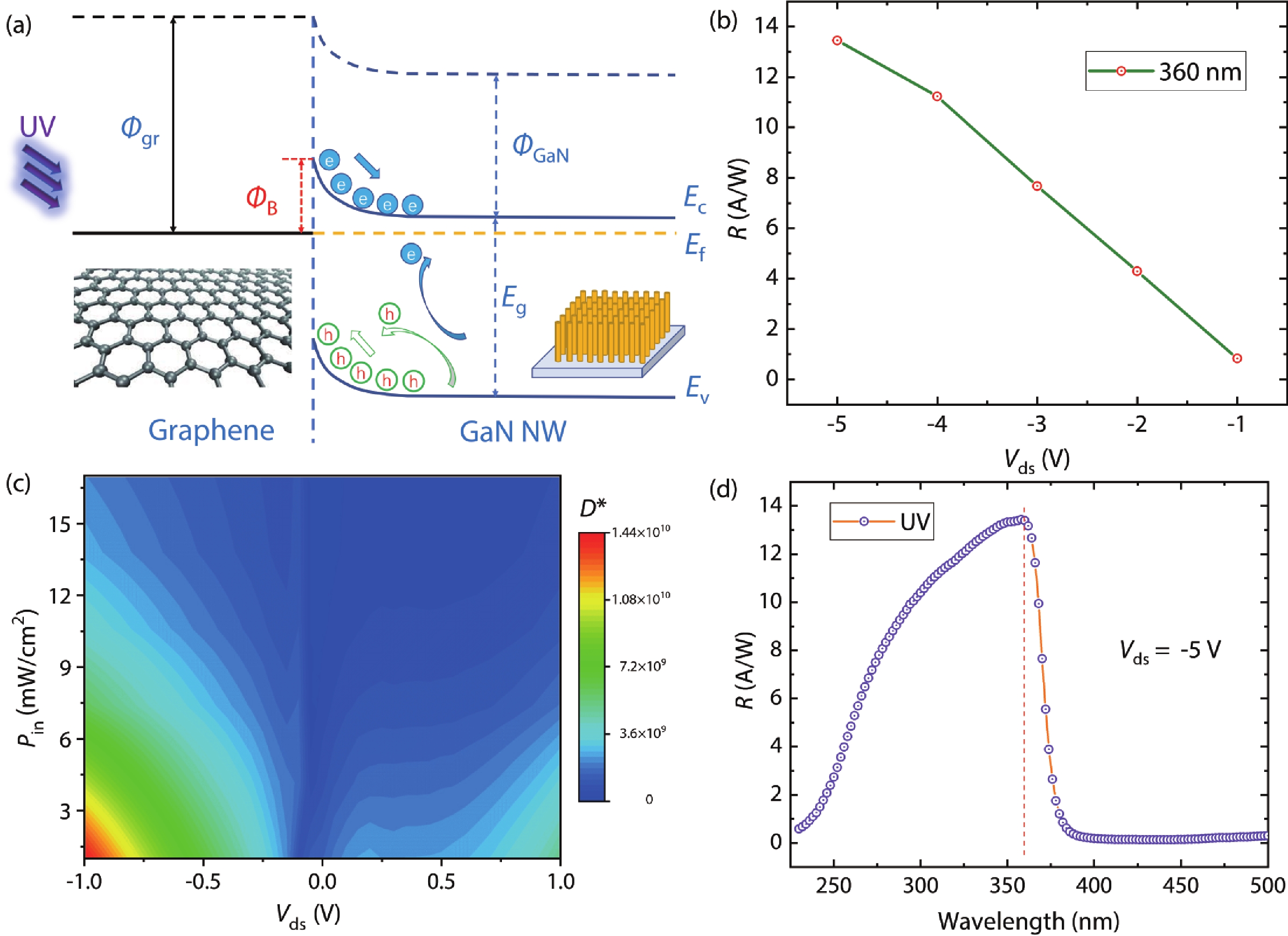| Citation: |
Xuemin Zhang, Changling Yan, Jinghang Yang, Chao Pang, Yunzhen Yue, Chunhong Zeng, Baoshun Zhang. Vertical Schottky ultraviolet photodetector based on graphene and top–down fabricated GaN nanorod arrays[J]. Journal of Semiconductors, 2022, 43(6): 062804. doi: 10.1088/1674-4926/43/6/062804
****
X M Zhang, C L Yan, J H Yang, C Pang, Y Z Yue, C H Zeng, B S Zhang. Vertical Schottky ultraviolet photodetector based on graphene and top–down fabricated GaN nanorod arrays[J]. J. Semicond, 2022, 43(6): 062804. doi: 10.1088/1674-4926/43/6/062804
|
Vertical Schottky ultraviolet photodetector based on graphene and top–down fabricated GaN nanorod arrays
DOI: 10.1088/1674-4926/43/6/062804
More Information
-
Abstract
GaN has been widely used in the fabrication of ultraviolet photodetectors because of its outstanding properties. In this paper, we report a graphene–GaN nanorod heterostructure photodetector with fast photoresponse in the UV range. GaN nanorods were fabricated by a combination mode of dry etching and wet etching. Furthermore, a graphene–GaN nanorod heterostructure ultraviolet detector was fabricated and its photoelectric properties were measured. The device exhibits a fast photoresponse in the UV range. The rising time and falling time of the transient response were 13 and 8 ms, respectively. A high photovoltaic responsivity up to 13.9 A/W and external quantum efficiency up to 479% were realized at the UV range. The specific detectivity D* = 1.44 × 1010 Jones was obtained at –1 V bias in ambient conditions. The spectral response was measured and the highest response was observed at the 360 nm band. -
References
[1] Dubey A, Mishra R, Hsieh Y H, et al. Aluminum plasmonics enriched ultraviolet GaN photodetector with ultrahigh responsivity, detectivity, and broad bandwidth. Adv Sci, 2020, 7, 2002274 doi: 10.1002/advs.202002274[2] Gundimeda A, Krishna S, Aggarwal N, et al. Fabrication of non–polar GaN based highly responsive and fast UV photodetector. Appl Phys Lett, 2017, 110, 103507 doi: 10.1063/1.4978427[3] Liu L, Yang C, Patanè A, et al. High-detectivity ultraviolet photodetectors based on laterally mesoporous GaN. Nanoscale, 2017, 9, 8142 doi: 10.1039/C7NR01290J[4] Yu R X, Wang G D, Shao Y L, et al. From bulk to porous GaN crystal: Precise structural control and its application in ultraviolet photodetectors. J Mater Chem C, 2019, 7, 14116 doi: 10.1039/C9TC04820K[5] Fang S, Wang D H, Wang X N, et al. Tuning the charge transfer dynamics of the nanostructured GaN photoelectrodes for efficient photoelectrochemical detection in the ultraviolet band. Adv Funct Mater, 2021, 31, 2103007 doi: 10.1002/adfm.202103007[6] Wang D H, Liu X, Fang S, et al. Pt/AlGaN nanoarchitecture: Toward high responsivity, self-powered ultraviolet-sensitive photodetection. Nano Lett, 2021, 21, 120 doi: 10.1021/acs.nanolett.0c03357[7] Razeghi M, Rogalski A. Semiconductor ultraviolet detectors. J Appl Phys, 1996, 79, 7433 doi: 10.1063/1.362677[8] Katz O, Garber V, Meyler B, et al. Gain mechanism in GaN Schottky ultraviolet detectors. Appl Phys Lett, 2001, 79, 1417 doi: 10.1063/1.1394717[9] Lee C J, Kang S B, Cha H G, et al. GaN metal–semiconductor–metal UV sensor with multi-layer graphene as Schottky electrodes. Jpn J Appl Phys, 2015, 54, 06FF08 doi: 10.7567/JJAP.54.06FF08[10] Wang S J, Geng Y, Zheng Q B, et al. Fabrication of highly conducting and transparent graphene films. Carbon, 2010, 48, 1815 doi: 10.1016/j.carbon.2010.01.027[11] Yang G, Li L H, Lee W B, et al. Structure of graphene and its disorders: A review. Sci Technol Adv Mater, 2018, 19, 613 doi: 10.1080/14686996.2018.1494493[12] Wang J, Song J, Mu X, et al. Optoelectronic and photoelectric properties and applications of graphene-based nanostructures. Mater Today Phys, 2020, 13, 100196 doi: 10.1016/j.mtphys.2020.100196[13] Lin F, Chen S W, Meng J, et al. Graphene/GaN diodes for ultraviolet and visible photodetectors. Appl Phys Lett, 2014, 105, 073103 doi: 10.1063/1.4893609[14] Babichev A V, Zhang H, Lavenus P, et al. GaN nanowire ultraviolet photodetector with a graphene transparent contact. Appl Phys Lett, 2013, 103, 201103 doi: 10.1063/1.4829756[15] Xu K, Xu C, Xie Y Y, et al. Graphene GaN-based Schottky ultraviolet detectors. IEEE Trans Electron Devices, 2015, 62, 2802 doi: 10.1109/TED.2015.2453399[16] Wang S Y, Chen R S, Ren Y, et al. Highly-rectifying graphene/GaN Schottky contact for self-powered UV photodetector. IEEE Photonics Technol Lett, 2021, 33, 213 doi: 10.1109/LPT.2021.3052171[17] Tian H J, Liu Q L, Hu A Q, et al. Hybrid graphene/GaN ultraviolet photo-transistors with high responsivity and speed. Opt Express, 2018, 26, 5408 doi: 10.1364/OE.26.005408[18] Yu F, Rümmler D, Hartmann J, et al. Vertical architecture for enhancement mode power transistors based on GaN nanowires. Appl Phys Lett, 2016, 108, 213503 doi: 10.1063/1.4952715[19] Wang D H, Liu X, Kang Y, et al. Bidirectional photocurrent in p–n heterojunction nanowires. Nat Electron, 2021, 4, 645 doi: 10.1038/s41928-021-00640-7[20] Yu F, Yao S B, Römer F, et al. GaN nanowire arrays with nonpolar sidewalls for vertically integrated field-effect transistors. Nanotechnology, 2017, 28, 095206 doi: 10.1088/1361-6528/aa57b6[21] Prabaswara A, Min J W, Subedi R C, et al. Direct growth of single crystalline GaN nanowires on indium tin oxide-coated silica. Nanoscale Res Lett, 2019, 14, 45 doi: 10.1186/s11671-019-2870-9[22] Zhang X D, He T, Tang W B, et al. Thermal oxidation of AlGaN nanowires for sub-250 nm deep ultraviolet photodetection. J Phys D, 2020, 53, 495105 doi: 10.1088/1361-6463/abb552[23] Liu G N, Wen B M, Xie T, et al. Top–down fabrication of horizontally-aligned gallium nitride nanowire arrays for sensor development. Microelectron Eng, 2015, 142, 58 doi: 10.1016/j.mee.2015.08.004[24] Behzadirad M, Nami M, Wostbrock N, et al. Scalable top-down approach tailored by interferometric lithography to achieve large-area single-mode GaN nanowire laser arrays on sapphire substrate. ACS Nano, 2018, 12, 2373 doi: 10.1021/acsnano.7b07653[25] Bae S K, Kim H, Lee Y, et al. Roll-to-roll production of 30-inch graphene films for transparent electrodes. Nat Nanotechnol, 2010, 5, 574 doi: 10.1038/nnano.2010.132[26] Ferrari A C, Meyer J C, Scardaci V, et al. Raman spectrum of graphene and graphene layers. Phys Rev Lett, 2006, 97, 187401 doi: 10.1103/PhysRevLett.97.187401[27] Zhang H C, Liang F Z, Song K, et al. Demonstration of AlGaN/GaN-based ultraviolet phototransistor with a record high responsivity over 3.6 × 107 A/W. Appl Phys Lett, 2021, 118, 242105 doi: 10.1063/5.0055468[28] Zeng C H, Lin W K, He T, et al. Ultraviolet-infrared dual-color photodetector based on vertical GaN nanowire array and graphene. Chin Opt Lett, 2020, 18, 112501 doi: 10.3788/COL202018.112501[29] Shen G Z, Chen H R, Lou Z. Growth of aligned SnS nanowire arrays for near infrared photodetectors. J Semicond, 2020, 41, 042602 doi: 10.1088/1674-4926/41/4/042602[30] Wu Y, Yan X, Zhang X, et al. A monolayer graphene/GaAs nanowire array Schottky junction self-powered photodetector. Appl Phys Lett, 2016, 109, 183101 doi: 10.1063/1.4966899[31] He T, Zhao Y K, Zhang X D, et al. Solar-blind ultraviolet photodetector based on graphene/vertical Ga2O3 nanowire array heterojunction. Nanophotonics, 2018, 7, 1557 doi: 10.1515/nanoph-2018-0061[32] Kumar M, Jeong H, Polat K, et al. Fabrication and characterization of graphene/AlGaN/GaN ultraviolet Schottky photodetector. J Phys D, 2016, 49, 275105 doi: 10.1088/0022-3727/49/27/275105 -
Proportional views






 DownLoad:
DownLoad:

















